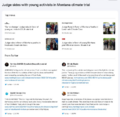Category:Montana: Difference between revisions
Siterunner (talk | contribs) No edit summary |
Siterunner (talk | contribs) No edit summary |
||
| (7 intermediate revisions by the same user not shown) | |||
| Line 8: | Line 8: | ||
* https://www.usgs.gov/centers/norock/science/retreat-glaciers-glacier-national-park?qt-science_center_objects=0#qt-science_center_objects | * https://www.usgs.gov/centers/norock/science/retreat-glaciers-glacier-national-park?qt-science_center_objects=0#qt-science_center_objects | ||
* https://inhabitat.com/only-25-glaciers-remain-in-montanas-shrinking-glacier-national-park/ | |||
* https://www. | * https://www.diyphotography.net/repeat-photography-demonstrates-how-glaciers-are-melting-away/ | ||
''A U.S. Geological Survey | |||
____________________________________________________________________________________ | |||
* [https://www.washingtonpost.com/news/energy-environment/wp/2018/03/07/trump-official-said-scientists-went-outside-their-wheelhouse-by-writing-climate-change-dramatically-shrunk-montana-glaciers/ '''''Climate Change dramatically shrunk Montana glaciers -- White House objects / Washington Post'''''] | |||
''A U.S. Geological Survey study documenting how climate change has “dramatically reduced” glaciers in Montana came under fire from high-level Interior Department officials last May (2017), according to a batch of newly released (2018) records under the Freedom of Information Act, as they questioned federal scientists’ description of the decline...'' | |||
''The USGS, the main scientific arm of Interior, publicly describes its mission as providing “impartial information” about the environment, including “the impacts of climate.” The agency has studied climate change since at least the 1970s.'' | |||
''Andrew Fountain, a geology professor at Portland State University who co-authored the study, said he had heard rumors that Interior officials were unhappy. “In short, they just didn’t like the idea we found yet more evidence of climate warming,” Fountain said.'' | |||
''(Trump administration Secretary of the Interior) Zinke — whose hometown of Whitefish, Mont. sits at the edge of Glacier National Park — questioned the extent to which human activities had fueled the shrinkage of glaciers in Montana and elsewhere when testifying before the House last June. At the same time, he suggested human emissions play a role in changing the broader climate.'' | ''(Trump administration Secretary of the Interior) Zinke — whose hometown of Whitefish, Mont. sits at the edge of Glacier National Park — questioned the extent to which human activities had fueled the shrinkage of glaciers in Montana and elsewhere when testifying before the House last June. At the same time, he suggested human emissions play a role in changing the broader climate.'' | ||
| Line 21: | Line 33: | ||
''He added that, regardless of cause, fewer glaciers may be better for Montana’s economy. The news release had alluded to the adverse “impact shrinking glaciers can have on tourism.”'' | ''He added that, regardless of cause, fewer glaciers may be better for Montana’s economy. The news release had alluded to the adverse “impact shrinking glaciers can have on tourism.”'' | ||
''“I could also make the argument that it’s not clear that tourism would necessarily suffer since touring season may expand, and hiking may replace | ''“I could also make the argument that it’s not clear that tourism would necessarily suffer since touring season may expand, and hiking may replace glacier-viewing..." | ||
| Line 40: | Line 52: | ||
[[Category:Climate Change]] | |||
[[Category:State]] | [[Category:State]] | ||
[[Category:United States]] | [[Category:United States]] | ||
Latest revision as of 02:12, 13 March 2018
Retreat of Glaciers in Glacier National Park
"It has been estimated that there were approximately 150 glaciers present in 1850 .... In 2015, measurements of glacier area indicate that there were 26 remaining glaciers...."
____________________________________________________________________________________
A U.S. Geological Survey study documenting how climate change has “dramatically reduced” glaciers in Montana came under fire from high-level Interior Department officials last May (2017), according to a batch of newly released (2018) records under the Freedom of Information Act, as they questioned federal scientists’ description of the decline...
The USGS, the main scientific arm of Interior, publicly describes its mission as providing “impartial information” about the environment, including “the impacts of climate.” The agency has studied climate change since at least the 1970s.
Andrew Fountain, a geology professor at Portland State University who co-authored the study, said he had heard rumors that Interior officials were unhappy. “In short, they just didn’t like the idea we found yet more evidence of climate warming,” Fountain said.
(Trump administration Secretary of the Interior) Zinke — whose hometown of Whitefish, Mont. sits at the edge of Glacier National Park — questioned the extent to which human activities had fueled the shrinkage of glaciers in Montana and elsewhere when testifying before the House last June. At the same time, he suggested human emissions play a role in changing the broader climate.
“I don’t believe it’s a hoax,” Zinke said. “I think man has had an influence. I think climate is changing. In reference to Glacier Park, glaciers started melting in Glacier Park right after the end of the ice age. It’s been a consistent melt.”
In the May 10 email thread, Indur Goklany, a science and technology policy analyst skeptical of climate change, responded by questioning what fraction of the glacial shrinkage is “human-induced as opposed to natural variations in precipitation.”
He added that, regardless of cause, fewer glaciers may be better for Montana’s economy. The news release had alluded to the adverse “impact shrinking glaciers can have on tourism.”
“I could also make the argument that it’s not clear that tourism would necessarily suffer since touring season may expand, and hiking may replace glacier-viewing..."
___________________________________________________________________
http://eros.usgs.gov/sites/all/files/external/imagegallery/2459.jpg
Pages in category "Montana"
The following 14 pages are in this category, out of 14 total.
B
M
U
- University of Montana Affiliating with the Workers Rights Consortium
- University of Montana Condemning the Use of "Taser" Guns
- University of Montana Farm to College Program
- University of Montana in Support of Forward Montana's Just Wages for UM Janitors
- University of Montana Integrated Pest Management Policy
- University of Montana No Interest Bike Loans
- University of Montana Sustainable Campus Committee
Media in category "Montana"
The following 2 files are in this category, out of 2 total.
- Montana climate trial News - 2023-08-14.png 789 × 768; 389 KB
- Wildfires 2021 - August.jpg 519 × 220; 54 KB

